According to statistics from the National Energy Administration, as of the first nine months of 2018, China's new grid-connected photovoltaic installed capacity was 34.5GW, and its cumulative grid-connected installed capacity was 165GW. The "531" photovoltaic new policy has made China PV, which has been rushing for several years, press the deceleration key, and the incremental scale has slowed down. The operation and maintenance of 150 million kilowatts of stock power stations have attracted much attention. For photovoltaic power plant holders, pursuing the maximum energy efficiency of the power plant and meeting the expected revenue of the power plant are the most core goals. Under the realistic background of limited space for cost reduction of photovoltaic equipment and increased difficulty in efficiency improvement, through refined operation and maintenance Requiring income from the power station has become the fastest way for the photovoltaic system to continue to reduce costs and increase efficiency. The premise of achieving the expected income is the safe and stable operation of photovoltaic assets. In recent years, due to defects in construction quality, improper equipment selection, and non-standard operation and maintenance management, cases of casualties and major property losses are common. Therefore, safety and security are the foundation and key to operation and maintenance. The maintenance, regular inspection and other means to scientifically and reasonably manage the power station in the operating life to ensure the safe, stable and efficient operation of the entire system.
1. Fire hazards and fire prevention measures
1.1 Hot spots of components
The hot spot phenomenon is a typical failure of the photovoltaic power generation system. As shown in Figure 1, it will not only reduce the power generation efficiency of the system, but also easily cause safety problems. The hot spots formed by the internal causes of the component have the virtual welding of the component, which is easy Causes an increase in resistance, causing the component to heat up. Severe hot spots at high temperatures can cause permanent damage to the battery such as partial burnout, melting of solder joints, destruction of grid lines, and aging of packaging materials. Local overheating can also cause glass breakage, backplate burn-through, and even component spontaneous combustion and fire. Spots have always been the most concerned issue in the operation and maintenance of power stations.
The leakage of the battery slice will affect the normal operation of the battery, thereby acting as a load and consuming the power of other normal batteries; the reliability of the diode is poor, and it cannot be bypassed in time. In addition, other factors of the module, such as external shielding and poor flame retardancy of the component materials, may cause fires in photovoltaic power plants.
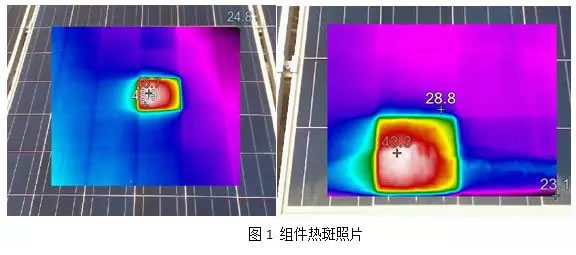
Precautions: You can use handheld infrared cameras or drones to regularly scan the components in the photovoltaic area, and evaluate the quality of the components through the test results. Since there is currently no uniform standard for the temperature range of hot spots, some companies use summer and The definition is not summer, such as summer, when the ambient temperature is greater than 35 ℃, the temperature of the glass surface of the component is greater than 90 ℃. During the non-summer season, the temperature difference of the glass surface is greater than or equal to 20 ° C as the criterion for hot spot judgment. Since the normal operating temperature range of the component is generally -40 to + 85 ° C, it is recommended to replace the component when the temperature continues to exceed 85 ° C.
1.2 Failure of component junction box
The junction box accepts the output energy from the component and is a carrier and an intermediary. Diode breakdown, short circuit or failure of the diode, virtual connection of the positive and negative leads of the component, and cracking of the junction box are common problems. If the junction box The sealing is relatively poor, air and water vapor are easy to invade, the resistance of internal components increases, accelerates corrosion, and eventually leads to burnout. Junction box heating may be due to poor contact or diode failure, but also buried potential safety hazards. There is a reverse current inside the diode. Each time the temperature rises by 10 ℃, the reverse current will double. The reverse current will reduce the current generated by the component and affect the power of the component. Therefore, the junction box must have excellent heat dissipation or special heat dissipation design. In the daily operation and maintenance work, it is recommended to use an infrared camera to regularly check the junction box heating problem, and handle it as soon as it is found.

1.3 Failure of photovoltaic connector
The photovoltaic connector accounts for less than 0.5% of the initial investment cost of the system, but it is a key component of the photovoltaic system. It ensures that the power generated by the system can be stably transmitted from the module to the inverter and the user. Based on the field operation and maintenance data of 746 power stations, the Horizon 2020 “Solar Bankability†project team of the European Union gave a list of power plant operation and maintenance TOP20 technical failures. "Burn out" ranks second in the failure list.
The failure of the connector is mainly due to its own quality, such as the contact resistance after the male and female connectors are mated. A good connector must have a very low contact resistance and can maintain a low contact resistance for a long time. According to the international standard EN50521 for photovoltaic connectors, the contact resistance must be less than or equal to 5mΩ. The second cause of failure is the inter-insertion of connectors between different brands. Due to differences in technology and product materials, differences in production processes and quality standards, inconsistent tolerances and different raw materials, 100% matching cannot be guaranteed. If forced to insert each other, it will cause problems such as temperature rise, contact resistance increase and IP level cannot be guaranteed, which will seriously affect the power generation efficiency and safety of the power station. Both TüV and UL have issued written statements that do not support connector insertion applications from different manufacturers. If you must use it, it is best to do a match test in advance.
As shown in Figure 2, the thermal imaging of a power station using an infrared thermal imager to work on the temperature of the superior and inferior photovoltaic connectors is obviously higher. Therefore, in the selection of connectors, we must choose high-quality connectors.
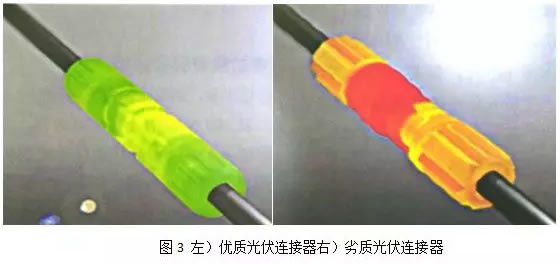
1.4 DC arc
According to a third-party investigation, more than 40% of the fire accidents in photovoltaic power plants are caused by DC arc faults. International standards such as NEC 690.11 require that a DC arc must be provided if the voltage between any two live parts in a photovoltaic system exceeds 80V. Detection and protection capabilities.
An arc is generated between the high voltage between the positive and negative polarities of the string. When the string is not generating electricity, the voltage appears as an open circuit voltage, which can generally reach up to 700V. Photovoltaic battery system is a kind of DC power generation device, and the fault arc caused by it is called "DC fault arc". The biggest difference between this and the general AC fault arc is that there is no idle periodic phenomenon caused by its phase change. In other words, once a DC fault arc occurs, high heat will be maintained until the power source disappears. Because the high heat generated by the fault arc can reach more than 1,000 degrees Celsius, it will not only cause the surrounding insulating material to decompose or carbonize to lose the insulating effect, but also easily cause the nearby materials to reach the ignition point and be ignited to fire, as shown in the left of Figure 4 Fired and burned the junction box of a power station. Observed from the burned photos, mainly concentrated on the input and output terminals of the circuit breaker, the temperature on the terminal is the highest, and there is no burning trace on the fuse and photovoltaic cable, which can exclude poor cable contact or short circuit, etc. Causes arcing on the fuse. The right side of Figure 4 shows that the wiring between the string and the combiner box is not firm, and there is a virtual connection phenomenon. In the process of operation, the bad contact causes the current to draw an arc. The high temperature melts the fuse holder and causes a short circuit, which burns the combiner box.
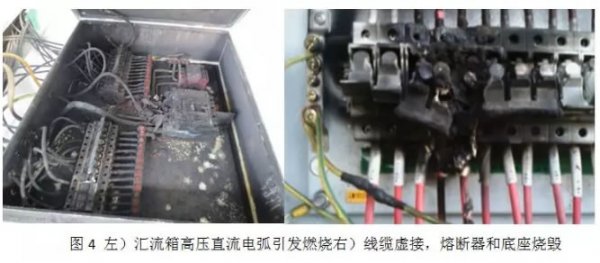
1.5 Other reasons
In general: direct current arcs, wildfires in nature, and artificial open flame sources can all cause fires.
Figure 5 shows a fire in a mountainous photovoltaic power plant. There is a certain vegetation on the ground, and there are too many weeds in the photovoltaic area. Due to the dry weather in winter, the vegetation is flammable, and there is an open fire. In addition, there is no effective protection and isolation within and outside the zone, which caused the fire to spread to the photovoltaic area.
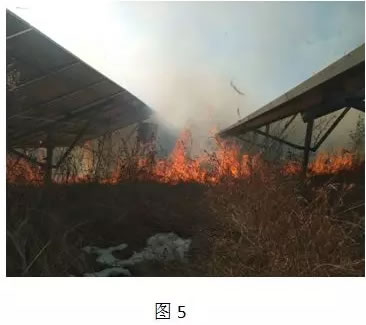
Precautions:
1) Fully monitor every corner of the photovoltaic plant.
2) With reference to the requirements in DL 5027-2015 Typical Fire Protection Regulations for Power Equipment, check the equipment and safety conditions of the fire protection facilities in the station to ensure their complete availability.
3) Emergency response measures for sudden fires should be prepared, and employees should be organized to conduct a practical drill to improve their ability to respond to fires and fire protection.
4) Strengthen the fire blocking of cable trenches, shafts, and bridges through walls. It is forbidden to store flammable, flammable, and combustion-supporting items in the cable trenches, and debris must be cleaned up.
5) Customs such as dry grass in winter monsoon, burning hills and sacrificial rites are very easy to cause fires, and plant vegetation needs to be cleaned up. Qualified power stations should be isolated from the outside area for fire and fire protection; key fire protection sites are hung up in obvious locations to prohibit smoking and fire warning sign. Do a good job in safety education, supervision and management of foreigners.
6) The power station shall carry out special patrols and special patrols in special seasons and time periods, keep the fire alert state at all times, and handle and deal with the fire in time.
2. Hidden dangers of natural disasters and preventive measures
2.1 Flood
The source of the photovoltaic power plant suffered from flood disasters is that it was not designed according to the correct specifications at the beginning of the power plant design. In the design and construction of photovoltaic power plants, structural flood control and artificial flood control are usually used to deal with flood disasters. Structural flood control is usually reflected in the design stage, with reference to the flood assessment impact report during design.
For photovoltaic power stations in different areas, the flood control standards should be treated differently. There are large differences in flood control levels and standards in different geographical locations. For the adjacent river and sea areas, a safety super high of + 0.5m is usually adopted. Consider the impact of torrents to add pile foundation elevation.
At present, for most projects, the design unit usually considers using the highest waterlogging level in 50 years as a reference standard to add an extra high. The actual situation will be adjusted according to the geographic location and flood control standard design.
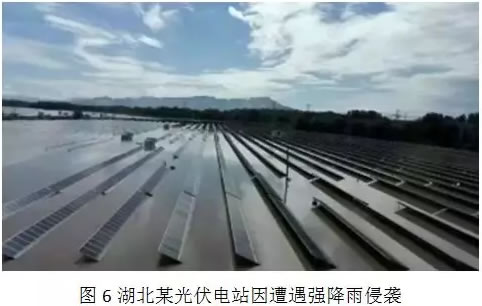
ã€Precautions】
Prudent site selection: In terms of hydrological conditions, the short-term maximum precipitation rainfall, water depth, flood water level, drainage conditions, etc. should be considered in many ways. The above factors will directly affect the design of the photovoltaic system ’s mounting system, mounting foundation, and the installation height of electrical equipment. If the depth of accumulated water is high, the installation height of components and other electrical equipment will be high. Flood water level affects the safety of the support foundation. Poor drainage conditions can cause long-term flooding of foundations and even metal supports.
Add protection systems such as drainage systems: The impact of heavy precipitation on the power station is mainly rainwater immersion. Ground power stations, Yuguang complementary power stations and water surface power stations should set up corresponding drainage facilities according to the meteorological and hydrological conditions of the location, or add them before the arrival of heavy precipitation Temporary drainage facilities.
Booster stations, power distribution rooms, pump rooms, box transformers, cable trenches and other facilities and equipment are prone to flooding and cover, and measures should be taken in advance for blocking.
The problems of soil erosion and subsidence within a small area or within the treatment capacity of the power station should be actively organized for backfilling after the power station is discovered to prevent further expansion of hidden dangers.
Formulate emergency plan: The first person in charge of power plant safety production should combine the characteristics of the unit's flood control work, formulate reasonable flood control measures and emergency plans, and conduct appropriate emergency treatment and safety assessment of matters that may cause power plant equipment loss and affect power plant safety; Effectively prevent and reduce the adverse effects caused by natural disasters such as landslides, debris flows, and landslides caused by heavy rainfall, and the collapse of power plant equipment foundations, road erosion, etc. Sensitivity, and timely grasp the development trend, make emergency supplies reserves (such as sandbags, drainage pumps, power trays, etc.) in advance. Once the equipment is out of power, it is necessary to find the cause as soon as possible and restore the equipment operation as soon as possible.
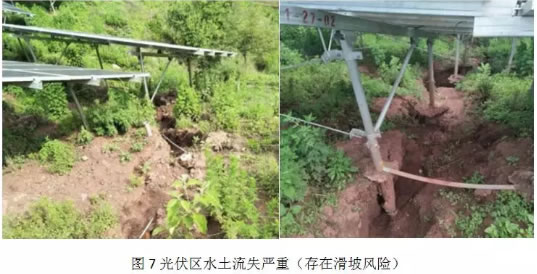
2.2 Storm
In 2017, a photovoltaic power plant was hit by strong winds and dust storms, and the wind did not stop until 16:00. During the period, the average wind speed was 16m / s, the instantaneous wind speed reached 30m / s, the instantaneous wind reached level 9, and there was a sandstorm for about half an hour, the minimum visibility was 299 meters, and the strong wind lasted nearly 6 hours. Was blown off.
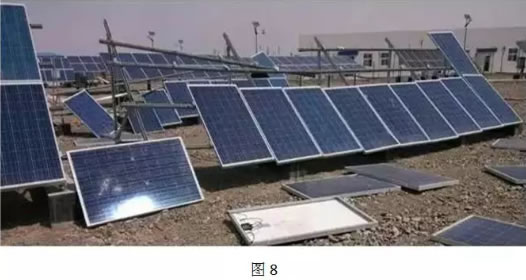
Precautions:
1) Improve the design requirements for the strength of photovoltaic brackets, component compacts, etc., and choose the component inclination angle with better wind resistance. For the place where the wind resistance is greater, the strength design of the bracket should be strengthened, and the galvanized steel bracket with higher strength should be used as much as possible.
2) In order to minimize the damage caused by storms, "prevention should be first, and management should be the priority." During the construction and operation period, an emergency plan for typhoon prevention should be established, and a systematic, standardized, and institutionalized response mechanism for typhoon prevention should be established. take effective action.
3) Sample inspection work is carried out on the photovoltaic module module block and its bolts and bracket column fasteners, especially the special sampling plan is formulated before the spring and autumn winds come, and the bolts are determined according to the implementation of the rolling inspection of bolts and the actual looseness during daily inspection Check the tightening ratio of the spot to judge the tightening degree of the evaluation bolts to ensure that the components are not damaged during the strong wind. Due to the different strength of the manual operation, the degree of tightness is different, and professional installation tools such as electric torque wrenches are required during construction.
4) In daily operation and maintenance, strengthen the inspection of the array and tighten and loosen the pressure block in time.

3. Photovoltaic insurance
According to the distribution of the industrial chain, PICC P & C has launched various forms of photovoltaic insurance, including 25-year power guarantee insurance for component manufacturers, professional liability insurance for power station builders, property insurance and machine damage insurance for completed power stations , Loss of profits insurance, public liability insurance, and compensation insurance for loss of power generation income after the power station is connected to the grid.
The scope of protection for all property risks: to cover direct property losses of photovoltaic power plants caused by natural disasters and accidents.
1) Natural disasters: refers to lightning strikes, rainstorms, floods, storms, tornadoes, hail, typhoons, hurricanes, dust storms, blizzards, icicles, earthquakes, sudden landslides, collapses, debris flows, sudden ground subsidence and other irresistible human forces A destructive natural phenomenon.
2) Accident: refers to unexpected events that cannot be controlled by the insured and cause material loss, such as fire or explosion.
Indirect loss insurance: Operational interruption and additional cost insurance, covering indirect losses caused by natural disasters, accidents, etc. that lead to the interruption of photovoltaic power plant operations, including the expected loss of power generation and subsidies and the increase in fixed costs.
The power station can choose appropriate insurance according to the actual situation to reduce property loss as much as possible.
4. Summary
Safety and security is an important task for the operation and maintenance of distributed photovoltaic systems. This article describes in detail the possible safety risks of the operation and maintenance of photovoltaic systems, including hidden fire hazards, hidden hazards of natural disasters, etc. As a rapid development, photovoltaic power generation In the industry, loopholes are prone to occur in various links such as design, construction, and equipment quality control. Operation and maintenance work should be multi-pronged, and management should be strengthened to prevent accidents before they can reduce safety risks at work.
Testing Equipment Of Guide Rail
Testing Equipment of Elevator Guide Rail
Inspection Equipment of Elevator Guide Rail
Detection Equipment of Elevator Guide Rail
testing facility of Elevator Guide Rail
measuring equipment of Elevator Guide Rail
We carry high quality Testing Equipment Of Guide Rail for all major elevator and escalator brands
for OTIS Elevators, ThyssenKrupp Elevators, Schindler Elevators, KONE Elevators, Mitsubishi Elevators, Fujitec Elevators, Hitachi Elevators, Toshiba Elevators, Fuji Elevators, Express Elevators, Sigma Elevators, LG Elevators, Hyundai Elevators, BLT Elevators, CANNY Elevators, SJEC Elevators, KOYO Elevators
Testing Equipment of Elevator Guide Rail, Inspection Equipment of Elevator Guide Rail, Detection Equipment of Elevator Guide Rail
CEP Elevator Products ( China ) Co., Ltd. , https://www.zjelevatordoorsystem.com